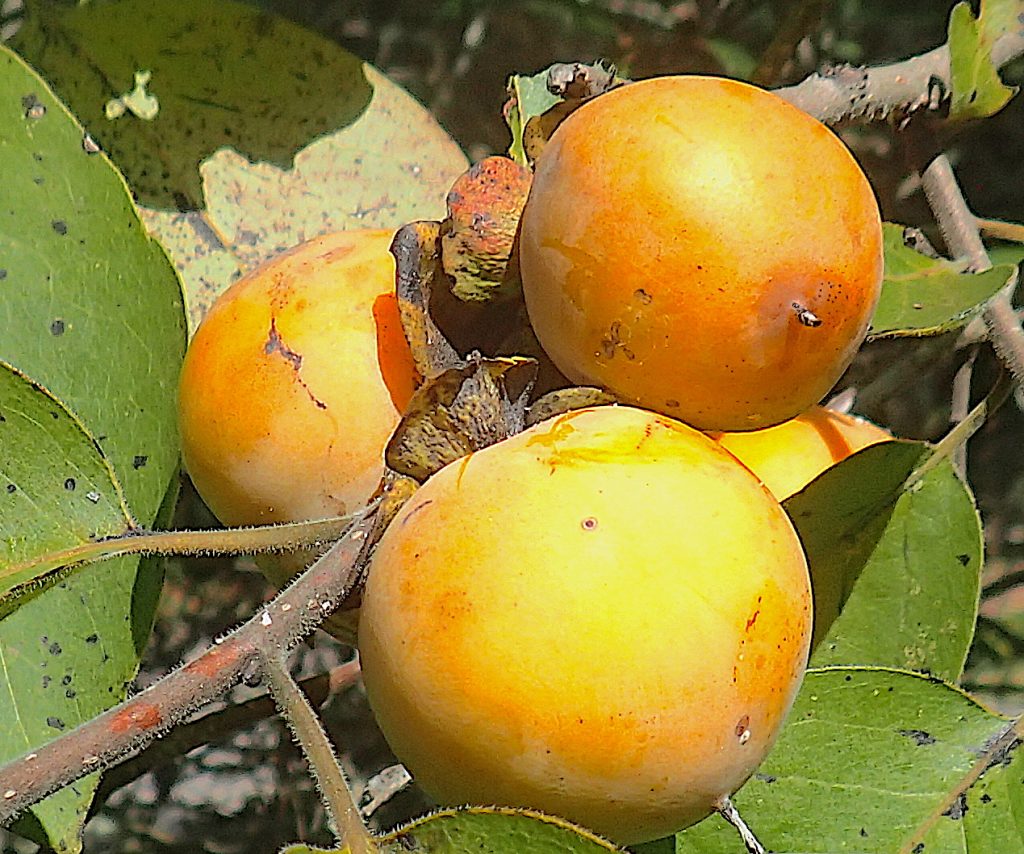
Persimmons can be astringent even after they fall. Photo by Green Deane
It was on the side of the bike trail, half squished. Neither fact was surprising. It was there last year and it fell a long distance: The first ripe persimmon of the season… well… it was almost ripe, sweet with a just detectable lingering hint of astringency.
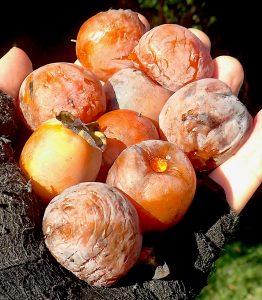
The best persimmons are the ones you have to fight the ants for. Photo by Green Deane
We recognize that plants do not have brains as most mobile creatures do. Yet, they can have a strategy. The Mahoe, for example, changes its blossom from yellow in the morning to red late in the day or night to attract different pollinators. The Lantana does that in reverse. It changes the color of a pollenated blossom so when a bee come by it lands on the newer, unpollinated blossom. Yellow Pond Lily seeds are bitter until enzymes work on them for about three weeks which is something similar to the persimmon. The persimmon fruit stays very puckery until the seeds are mature enough to germinate. Then the fruit turns sweet. And that is just part of the tree’s strategy: It only wants creatures that can taste sweet to distribute the seeds. That eliminates any animal in the cat family as they can’t taste sweet. But that does include bears, dogs, raccoons, and humans. Why? Perhaps those creatures wander farther or have scat that is a better fertilizer. It might be they have a different digestive system that makes the seeds more willing to germinate… or all of the above.
Locally persimmons are mostly ripe by mid-October, sooner farther north. But I have also seen persimmons ripen here as late as January. September to January is quite a spread. Aim for the Ides of October. To read more about persimmons go here.
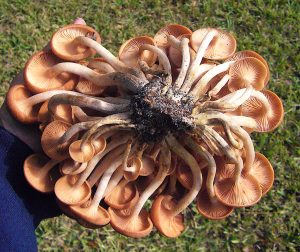
These prime Ringless Honey Mushrooms are cespitose, all growing out of one spot. Photo by Green Deane
There are several edible wild mushrooms available now. Chanterelles usually can be found well into October and occasionally even later depending upon rain. The “Milk Caps” are common now and their presence, too, is helped by rain. Just as one persimmon has pushed the season there have been reports of Ringless Honey Mushrooms flushing early here and there. Indeed, two weekends ago I saw some in Orlando. Ringless Honey Mushroom usually become noticeable locally during the first two of weeks of November, give or take a little. When I was in North and South Carolina at the end of August they were flushing everywhere. Ringless Honey Mushroom are…. well… an amber honey color hence the name. They have a white spore print — that’s very important — and are “cespitose.” That means a huge bunch of them will grow from one small point. I think the only other local mushroom to do that are Hypolomas aka Sulphur Tufts. Those, however, are on the yellow side, have greenish gills, and a black spore print. They are not edible. I like the flavor of Ringless Honey Mushroom and I don’t have to over cook them. Some folks have to or they get a little gastric distress. And once the weather cools a little we should see Oyster Mushroom flushing. To read more about the Ringless Honey Mushroom, go here.
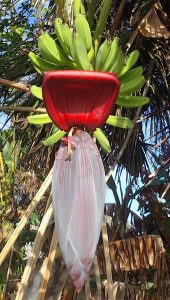
Below the unripe bananas is the purple blossom. You eat the inside part. Photo by Green Deane
Bananas are blossoming and fruiting now. It takes nearly two years and two warm winters to get bananas locally. Most people don’t know that nearly all of the banana “tree” is edible (like the Papaya, whether it is a tree or an herb is a bit of a debate particularly with the Papaya.) Banana blossoms are edible raw or cooked and often are pre-soaked in salted water. Of course soft bananas are edible. If you have hard bananas even when ripe (most of the wild ones are that way) you can cook and eat the banana seeds. Also the inner pith of the banana stalk is edible, raw or cooked. I had a friend who escaped with other children from Cambodia to Vietnam during the socialist takeover of Cambodia. Her entire family, except for herself, was among the several million killed as the revolutionaries forced the capitalist country into socialism. It took the orphans two years of walking through the jungle to get to Vietnam (where upon in time she became a Judo champion… She’s one tough woman.) The kids — who now consider themselves family as they have no one else — lived off banana stalks. Also, if you cut a banana down and hollow out the stump the first water that seeps back in can be used to treat kidney stones. You can read about bananas here.

Classes are held rain or shine or cold.
Foraging Classes: As you might infer by the lead story we saw ripening persimmons in our Cassadaga foraging class Saturday. In Largo was happily blossoming. I think it is too salty in Port Orange to see Smartweed this Saturday but I know it grows in West Palm Beach where I have a foraging class Sunday. The only question is season. At the same latitude plants on Florida’s coasts can vary from each other by six weeks. I’ll find out Sunday!
Saturday, September 22, Spruce Creek Park, 6250 Ridgewood Ave. Port Orange, 32127. 9 a.m. to noon.
Sunday, September 23rd, Dreher Park, 1200 Southern Blvd., West Palm Beach, 33405. 9 a.m. to noon. Meet just north of the science center. This class will be held regardless of size.
Saturday, September 29th, Boulware Springs Park, 3420 SE 15th St., Gainesville, FL 32641. 9 a.m. to noon. Meet at pavilion near pump house.
Sunday, September 30th, Blanchard Park, 10501 Jay Blanchard Trail, Orlando, Fl. 32817. 9 a.m. to noon. Meet at pavilion by the tennis courts by the YMCA building.
To read more about the classes go here.
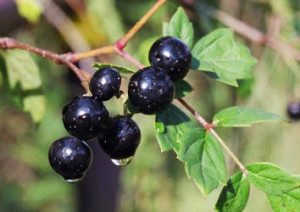
Peppervine got that name for a reason.
Dont’ eat that Peppervine… or if you do you’re own your own. Peppervine, Ampelopsis arborea, is much debated and easy to find now. It is closely related to the edible grape but also the toxic Virginia Creeper. It’s one of those plants that some folks say is definitely toxic and others say definitely edible. My personal experience is that off the vine it is not edible. But, I know some credible foragers who say they have eaten the ripe berries for a long time with no issue. No doubt the problem has to do with annual calcium oxalate production. Peppervine (so-called because the fruit can give a pepper-like burn) apparently can make little to a lot of the chemical each year, varying greatly. Another factor is method of preparation. I first got an inkling of this several years ago and put it in my newsletter then. I knew someone who picked Peppervine berries thinking they were grapes. He juiced them intent on making wine but then got interrupted. So he put the juice in the refrigerator for a while. The acid settled to the bottom leaving useable juice. Merriwether, of Foraging Texas, who’s also a scientist, goes a few steps further. First he crushes the fruit and strains out any solids leaving just juice. Then he lets the juice rest giving the acid a chance to settle. Once separated he carefully pours off the juice while draining it through a coffee filter leaving the dregs. Sounds like a plan. Off the bush I have never have a Peppervine berry that did not burn my mouth. (Lime juice is good for that, or, if no lime juice, lemon juice. Citric acid is the key.)

Green Deane DVD set of 135 videos
All of Green Deane’s videos are available for free on You Tube. They do have ads on them so every time you watch a Green Deane video I get a quarter of one cent. Four views, one cent. Not exactly a large money-maker but it helps pays for this newsletter. If you want to see the videos without ads and some in slightly better quality you can order the DVD set. It is nine DVDs with 15 videos on each for a total of 135 videos. Many people want their own copy of the videos or they have a slow service and its easier to order then to watch them on-line. The DVDs make a good gift for that forager you know especially on long, cold winter months. Individual DVDs can also be ordered or you can pick and choose. You can order them by clicking on the button on the top right hand side of this page (if your window is open wide enough.) Or you can go here.

Green Deane Forum
Want to identify a plant? Need to identify a plant? Looking for a foraging reference? Maybe you have a UFO, an Unidentified Flowering Object, you want identified. On the Green Deane Forum we — including Green Deane — chat about foraging all year. And it’s not just about warm-weather plants or just North American flora. Many nations share common weeds so there’s a lot to talk about. There’s also more than weeds. The reference section has information for foraging around the world. There are articles on food preservation, and forgotten skills from making bows to fermenting food. Recent topics include: I Finally Found Wapato, Looks like Corn, Weed With Pod At Top, A Mile Walk In The Woods, Chicken of the Woods?, Elderberry Fungus, Spurge Nettle 2018, Does Anybody Know This Berry, and Five-Minute “English” Muffin with Beautyberries. You can join the forum by clicking on the button in the menu line.
This is weekly issue 322.
If you would like to donate to Eat The Weeds please click here. Or you can use my Go Fund Me link, or by writing to Green Deane POB 941793 Maitland FL, 32794


Wow, the story of your friend from Cambodia sure made me appreciate my life, how wrenching! And the kidney stone reminder was painful too, agony! I used to get them regularly until I saw Forks Over Knives and decided to give a plant based diet a 30 day trial for all the health issues I had. That was 7 years ago and never felt better, food really is amazing medicine! After years of monthly Dr appts. and a bag full of crappy pills, I haven’t had to go in years. Plants rule!